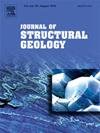Lattice preferred orientation of pyrrhotite in a sheeted vein complex of the Mokrsko-West gold deposit of Central Bohemia as investigated by the anisotropy of in-phase and out-of-phase magnetic susceptibility
IF 2.9
2区 地球科学
Q2 GEOSCIENCES, MULTIDISCIPLINARY
引用次数: 0
Abstract
Preferred orientation of pyrrhotite by crystal lattice in varied mineralized rocks was investigated by means of the anisotropy of magnetic susceptibility. The study area is mineralized contact of Neo-Proterozoic meta-volcanics with Variscan Sázava tonalite in the Central Bohemia. The contact crops out in the Josef Gallery located in the Mokrsko-West gold deposit. Magnetism of the investigated rocks is dominantly carried by pyrrhotite associated with the Mokrsko-West gold mineralization. In meta-volcanics, pyrrhotite basal planes are parallel to the cleavage and were preferably oriented through recrystallization or neocrystallization in an anisotropic stress field and/or through mechanical reorientation due to ductile deformation of the host rock. In tonalite, pyrrhotite basal planes are parallel to dominating steep joints. This preferred orientation evidently originated through oriented crystallization from mineralizing fluids into microcracks hosting quartz veinlets. Steep to vertical intersections come from differently striking vertical joints hosting mineralizations.
利用同相磁化率和非相磁化率的各向异性研究波希米亚中部Mokrsko-West金矿床片状脉状杂岩中磁黄铁矿的晶格优选取向
利用磁化率各向异性研究了磁黄铁矿在不同矿化岩石中的晶格择优取向。研究区为波希米亚中部新元古代变质火山岩与Variscan Sázava闪闪岩的矿化接触。接触在位于Mokrsko-West金矿的Josef画廊中出现。研究岩石的磁性主要由与莫克斯科-西金矿化有关的磁黄铁矿携带。在变质火山岩中,磁黄铁矿基面与解理平行,并通过各向异性应力场中的再结晶或新结晶和/或由于寄主岩石的韧性变形而产生的机械重定向而优选定向。在闪长岩中,磁黄铁矿基面平行于占优势的陡节理。这种择优取向显然源于矿化流体进入含石英细脉的微裂纹的定向结晶。陡峭到垂直的交叉点来自不同走向的垂直节理承载矿化。
本文章由计算机程序翻译,如有差异,请以英文原文为准。
求助全文
约1分钟内获得全文
求助全文
来源期刊

Journal of Structural Geology
地学-地球科学综合
CiteScore
6.00
自引率
19.40%
发文量
192
审稿时长
15.7 weeks
期刊介绍:
The Journal of Structural Geology publishes process-oriented investigations about structural geology using appropriate combinations of analog and digital field data, seismic reflection data, satellite-derived data, geometric analysis, kinematic analysis, laboratory experiments, computer visualizations, and analogue or numerical modelling on all scales. Contributions are encouraged to draw perspectives from rheology, rock mechanics, geophysics,metamorphism, sedimentology, petroleum geology, economic geology, geodynamics, planetary geology, tectonics and neotectonics to provide a more powerful understanding of deformation processes and systems. Given the visual nature of the discipline, supplementary materials that portray the data and analysis in 3-D or quasi 3-D manners, including the use of videos, and/or graphical abstracts can significantly strengthen the impact of contributions.
 求助内容:
求助内容: 应助结果提醒方式:
应助结果提醒方式:


